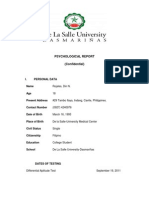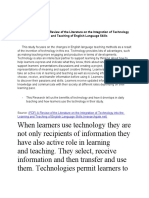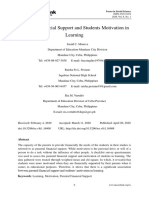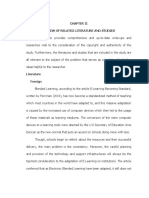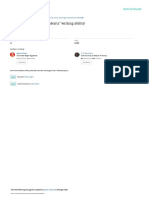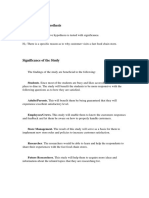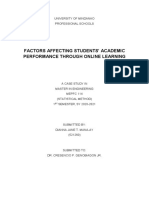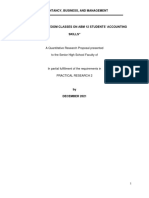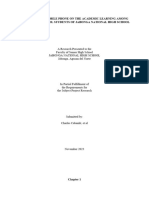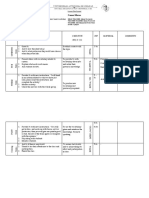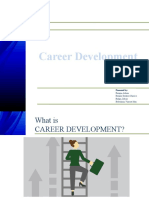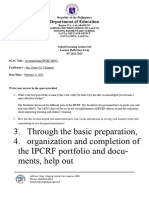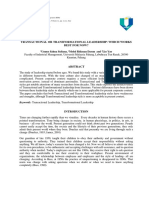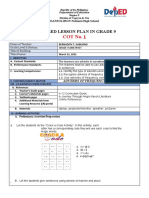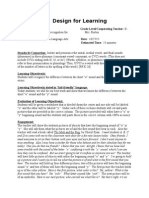Communication Barriers Affecting Students
Uploaded by
JoevinCommunication Barriers Affecting Students
Uploaded by
JoevinCOMMUNICATION BARRIERS AFFECTING STUDENTS’ OF COLLEGE OF
COMPUTING STUDIES IN WESTERN MINDANAO STATE UNIVERSITY
ACADEMIC PERFORMANCE IN CYCLICAL LEARNING MODALITIES
THIS RESEARCH PROPOSAL IS PRESENTED IN PARTIAL FULFILLMENT OF THE
REQUIREMENTS IN CAS 101
ORADA, ADRIAN U.
CONVOCAR, AIMMAN A.
SAPPARI, ALFAISAL M.
ANSOC, JOEVIN C.
LABACANACRUZ, GERALD LLOYD
OCAMPO, ISRAEL S.
SAHIBUL, JAYTHOON JR.
NOVEMBER 2022
Keynard L. Ponce
Research Adviser
Chapter I
Introduction
Background of the Study
During the pandemic, modern technology was of convenience to everyone. Education was
done through online learning and that became the new norm to students globally. However After
the decline of the Covid-19 pandemic, face-to-face learning has become a challenge for
universities to adapt to contemporary changes. Most of the universities try to improve their
educational system in order to meet the standard education for its students. Western Mindanao
State University implemented the cyclical learning modality in which students can learn through
face-to-face and online learning. Communication barriers have been a problem even before the
pandemic, they happen in every communication an individual makes everyday.
Communication is an act of which we want to express or say what we feel and think. We
communicate with people every day through our phones, letters, social media, etc. Most of our
communications are done in places like our home, school, and workplace, in other words face to
face. We rely on our communication skills to further form friendships, express our opinions and
even ask for help.
According to LISBDNETWORK 2014, Communication is an important part of trying to
convey information. Students also have to be able to communicate effectively with each other.
There are a number of factors in the classroom (and many of these factors exist in day-to-day life
as well) that can act as barriers to effective communication. Communication barriers hinder our
ability to receive and comprehend the information being conveyed by others through their
messages, ideas and thoughts that can obstruct or interfere with one another, and the point you're
attempting to make. There are many different types of communication barriers that may cause
ineffective communication.
Statement of the Problem
This study aims to find out the Communication barriers affecting student’s academic
performance in cyclical learning modalities. Specifically, this study seeks to answer the following
questions:
1. What are the communication barriers that affect a student’s performance in cyclical
learning modality?
2. What causes these communication barriers to occur?
Significance of the Study
Knowing Communication barriers that affect Cyclical Learning is a big step in overcoming
difficulties of a student. This study aims to ascertain the barriers that students have in
communicating in a cyclical learning. Also, this study investigates what causes these barriers and
suggests ideas on wats to overcome them.
Scope and Delimitation of the study
This study is focused on the different types of communication barriers affecting students
of the CCS (College of Computing Studies) in WMSU (Western Mindanao State University)
towards their academic performance in Cyclical Learning Modalities. Their study will be based on
a survey of 50 individuals divided by their genders at each year level. Determining the factors that
contribute to communication barriers that hinders the academic performance of a student in a
cyclical learning modality. Acknowledge in depth significance in the effectiveness of cyclical
learning modality in today's developing times.
Chapter II
Review of Related Literature and Studies
Conceptual Literature
In this chapter, an overview of the related literature and studies that are in line with the
research topic is discussed in order to provide an in-depth understanding of the objectives of this
research. This section presents relevant studies about communication barriers affecting students'
academic performance in cyclical learning modalities.
Communication barriers
According to Rani (2006), anything that interferes with our ability to hear and
comprehend the information, ideas, and thoughts of others is a communication barrier.
There are (number) types of communication barriers that she Identified that can cause
communication barriers in cyclical learning modality. This includes: the attitudinal
barriers, behavioral barriers, cultural barriers, language barriers, and environmental
barriers.
Attitudinal Barriers
Attitudinal barriers are products of one's attitude and assumptions shaped
through external and internal experiences (Roy, 2022). Where in the way a person
communicates depends on his or her values, attitude, beliefs, and perception of
other people. (Rani, 2006). An example scenario: an individual (person A) wants
to converse with a speech-impaired person (person B), before the communication
even happens, Person A assumes that Person B will not understand anything that
Person A says, resulting in Person A having to talk to Person B indirectly or not at
all. Other examples are: thinking that people with intellectual disabilities are not
capable of making decisions; avoiding a person for fear of saying the wrong word
or something that may offend other people; interrupting when other people are
speaking; dominating group sessions or discussions; and listening to opinions rather
than facts. This type of barrier can be a major obstruction to effective
communication; it prevents other people from maintaining and creating
relationships, as well as making a person biased towards others. (Roy, 2022)
Behavioral Barriers
Behavioral Barriers occur when the way you act towards others has bias,
prejudice, generalization and stereotype. Negative behavior contributes to the
ineffectiveness of communication and learning towards our teachers and fellow
classmates. Stereotyping occurs when you assume we know something about a
person because of their cultural or social background. Our views may come from a
bias you may have against a particular behavior, appearance, possession or even a
particular geographical area (Rani, 2016)
Physical Barriers
They include barriers like noise, closed doors, faulty equipment used for
communication, closed cabins, etc. Sometimes, in a large office, the physical
separation between various employees combined with faulty equipment may result
in severe barriers to effective communication.
Technological Barriers
Technological barriers are described as limited access to useful, relevant,
and appropriate hardware and software, especially in “instances where the use of
the technology is perceived as not being sufficient to perform the tasks or
accomplish the objectives for which the technology was initially utilised” [87].
Technological barriers are often reported as a significant cause of poor
implementation and diffusion rates in developing countries [88]. (Yvonne O’
Connor, John O’ Donoghue 2016)
Environmental Barriers
According to Kapur (2020), environmental barriers are communication
barriers that occur within a physical environment and obstruct the communication
process. To have effective communication, the environmental conditions must be
favorable so that the meaning of the message will not be obstructed. Some
environmental barriers are manageable, and some are difficult to deal with. If these
environmental barriers are not dealt with or managed properly, they may cause
distraction, inattentiveness, miscommunication, misinterpretation, and perplexity.
Other than the list of communication barriers previously mentioned, there are other
barriers to effective communication, as Kapur (2018) defined as psychological barriers.
These are: 1. Academic culture - it is when student's that came from different backgrounds
have difficulties in understanding a certain concept due to being unable to comprehend that
concept from a different perspective through a logical point of view. 2. Marital barriers -
occurs in married people, these barriers are caused by irrelevant information,
misunderstandings, insecurity and fear which results in separation or divorce. 3.
Communication flow - due to limited knowledge, a person can only communicate to a
certain extent. People who have inadequate information find it difficult to have effective
communication. That being said, communication barriers are not only limited to
demographic aspects and external interference, psychological factors can also affect the
effectiveness of communication between people.
Barriers in teaching and learning
Commonly, when teaching, instructors live under the impression that the contents
of the material that they are teaching using words and messages are fully received and
understood by the students. However, that is not always the case. The reason is that the
explanation or message received tends to be more or less close to the original meaning, and
in some cases, the message is received differently. (Duţă, 2015)
As the source of communication, the instructor should have proper knowledge and
confidence in his or her expertise on the topic that he or she discusses with the students.
The success of the instructor in delivering the messages effectively depends on his or her
overall behavior, personality, and the strategies he or she applies inside the classroom. It is
also the teacher's responsibility to choose and modify the source material to make it
relevant to the learners' interests and needs, regardless of their socio-economic background.
Nevertheless, effective communication can only be carried out if the students are
cooperating and involved themselves. (Pal et al., 2016)
In a study conducted by Malek (2016), both teachers and students were interviewed
about communication barriers that they experience in school. It was found that the most
common communication barrier that students experience is language. The teachers, on the
other hand, have three common communication barriers that they experience when
teaching the students. These barriers are cultural, perceptual, and linguistic. Moreover, the
study also identified the factors that cause these barriers to occur, namely: conflict, lack of
knowledge, various interpretations of language, lack of language ability (limited
vocabulary), differing emotional states, and different backgrounds.
Communication Barriers in Distance learning
One of the students' problems in distance learning is the perceived lack of contact
with or feedback from the instructor. Because there is no face-to-face contact with the
teachers, students find it hard to self-evaluate themselves. The separation of students and
teachers due to distance learning takes away a significant "connection" that is crucial for
the teacher-student relationship. (Galusha, 1997)
In a mixed-approach study conducted by Isman and Altinay (2005), they concluded
that internet connection and accessing create barriers both physically and psychologically
for the students as well as the teachers. They also pointed out that problems in language
require semantic barriers in a communication process, and technical barriers occur due to
technological factors present in communication. In addition, the students reflected that they
have psychological problems that are caused by certain factors such as stress, feeling
uncomfortable, anxiety, and fear of uncertain circumstances that may arise due to
ineffective communication. Isman & Altinay (2005) also stated that teachers also need to
improve their teaching effectiveness in virtual contexts, as barriers change according to the
perceptions of students and teachers. Barriers that were identified in this study are
technological, physical, semantic, and psychological.
As technologies nowadays offer easier, faster and globalized communication for
learning, the number of communication barriers also increases both in numbers and
complexity. These communication barriers present in a distance education can also
influence actual communication and may hamper student's performance and learning
experience (Berge, 2013).
Alawamleh et al. (2020) conducted a quantitative research study that aims to
explore whether online classes have a negative impact on student and teacher
communication. They found out that students prefer to conduct classes face-to-face rather
than virtually due to the challenges that they face when taking online classes, such as
decreased understanding and lack of motivation to study given material, decreased levels
of communication between student and teacher, and an increased feeling of isolation
among students due to online classes. They also point out that online learning has a negative
impact on the effectiveness of communication and the communication between teachers
and students.
Research Literature
To sum up, most of the previous studies mentioned defined and identified various
communication barriers that are present in the communication process particularly in school
setting as well as in virtual setting. Some of these barriers can overlap and cause more complex
problems that hinder the effectiveness of communication between students and teachers. Previous
studies had also provided countermeasures to lessen these obstacles. That being said, with the
contribution of these previous studies, further research must be done to observe the effects or
impact of these communication barriers on the students’ academic performance especially in the
new method of learning which is the cyclical learning modalities; and identify other
communication barriers that may occur in this mode of learning in the future.
Theoretical Framework
This study is anchored on two(2) different theories namely; the Communication Theory,
this theory focuses on various barriers to distance and face-to-face education. Communication
barriers are obstacles which prevent something from getting through to its destination, barriers
may lead your message getting distorted. In this theory the types of barriers mentioned includes;
Personal/Socio-psychological barriers, Physical/Environmental barriers, Mechanical barriers,
Semantic/Linguistic barriers, Cross-cultural barriers and Organizational barriers. And the Blended
learning theory, this theory refers to the combination of in-person and online teaching as a special
form of learning called “blended”. This theory provides theoretical foundations for the successful
implementation of blended learning. According to the U.S. Department of Education (Means,
Toyama, Murphy, Bakia, & Jones, 2009), a blend of classroom and web-based teaching and
learning offers access to the widest range of learning modes and methods for developing student
skills and expertise as learners (Cleveland-Innes, 2017). Many findings on blended learning show
an increase in learners’ ability to learn collaboratively, think creatively, study independently and
tailor their own learning experiences to meet their individual needs. Communication is an
important part of teaching because the students have to be able to understand the message that the
teacher is trying to convey. Students also have to be able to communicate effectively with each
other. There are a number of factors in the classroom that can act as barriers to effective
communication. Communication barriers include; noise, invisibility, inaudibility, environmental
and physical discomfort, distractions, lack of motivation, poor time management, slow-internet
connection and other technical issues are some of the barriers that students and teachers experience
during the interaction/communication.
Conceptual Framework
INDEPENDENT VARIABLE DEPENDENT VARIABLE
Communication Barriers Student’s Academic Performance
MEDIATOR VARIABLE
Attitudinal Barriers
Behavioral Barriers
Cultural Barriers
Environmental Barriers
Physical Barriers
Technological Barriers
Figure 1. Conceptual Framework
Figure 1 presents the conceptual framework of the study. Communication barriers as
Independent variable, Attitudinal barriers, Behavioral barriers, Cultural barriers, and
Environmental barriers, Physical and Technological Barriers as Mediator variable
and Student’s Academic performance as dependent variable. In figure 1. Communication
barriers as independent variables pertain to problems that come across during the
interaction, these barriers occur unanticipated during the face-to-face and online
interaction. The mediator variable which are the Attitudinal barriers, Behavioral barriers,
Cultural barriers, and Environmental barriers, Physical Barriers, and Technological
Barriers are the variables that are produced by the independent variable that could affect
the dependent variable of the study. The dependent variable which is the student’s
academic performance. Communication is essential in learning-teaching process, however
when communication barriers occur, these barriers could affect the overall academic
performance of the students.
Research Hypothesis
HO: There are significant amount of communication carriers that affects students academic
performances in cyclical learning modalities
Definition of Terms
Cyclical learning modality - refers to the learning method wherein some students are allowed to
have face-to-face classes while other students are utilizing the online learning method.
Distance learning - refers to the learning method that doesn't require face to face interaction;
classes are conducted virtually.
Blended learning - refers to a learning method that combines traditional classroom instructions
with online learning.
Barriers - Anything that obstructs the meaning of the message being delivered.
Modality - Refers to the method used for learning/teaching.
Prejudice - A preconceived opinion or judgment.
Stereotype - It refers to the unfair belief that all people or things with a particular characteristic
are the same.
Ethnocentrism - It refers to the perception of an individual that one's own culture is superior while
other cultures are perceived to be inferior.
Semantics - It refers to the meaning (of words) in a language.
Effective communication - It occurs when the message from the sender is received and
understood by the receiver.
Perplexity - A state of being confused because of difficulty in understanding the message.
Chapter 3
Methodology
Research Design
This study is a Quantitative research, the researchers will focus on determining what are
the different communication barriers that affect the effectiveness of students towards their
academic performance. A descriptive research design will be utilized in this study as it aims to
through naturalistic observation, case studies, and surveys to derive results.
Population and Sampling Procedure
The population for this research is the entire students of CCS (College of Computing
Studies) in WMSU (Western Mindanao State University) in the year 2022. The respondents will
consist for every year level under the CCS (College of Computing Studies) department which are
the Computer Science and Information Technology department. The researchers will use Slovin's
formula for population and sampling.
Research Instrument
For the presented study, the research instrument that the researchers will utilize is a
survey questionnaire containing close-ended questions in order to effectively measure variables
under the study base from the responses of the respondents. The survey will be disseminated
online to allow the respondents to answer the survey at their own convenience.
Data Gathering Procedure
Google Forms will be utilized for the survey as it is low-cost and is able to be distributed
at a large scale. The uploaded survey on the internet will be distributed in all College of
Computing Students using Slovin’s formula, to the random respondents
online for about a month from a single semester.
Data Analysis Procedure
After collecting the data from the respondents, the researchers will summarize and
organize the gathered data and utilize statistical data analysis as well as inferential statistics to test
the researchers' hypothesis to generate objective findings at the end of the study.
Statistical Treatment of Data
The study will be using a Likert Scale to serves as the guide for interpreting the data
gathered.
Scale Weighted Means/Equivalent Corresponding Remarks
5 4.20-5.00 Always
4 3.40-4.19 Often
3 2.60-3.39 Sometimes
2 1.80-2.59 Rarely
1 1.00-1.79 Never
Literature Review References:
Adler, N. J. (1991). Communicating across Cultural Barriers. Interkulturelle
Kommunikation: Texte Und Übungen Zum Interkulturellen Handeln. Sternenfels:
Wissenschaft & Praxis.
https://www.academia.edu/download/51496842/NancyAdlerCrossCultComm..pdf
Alawamleh, M., Al-Twait, L. M., & Al-Saht, G. R. (2020). The effect of online learning on
communication between instructors and students during Covid-19 pandemic. Asian
Education and Development Studies, 11(2), 380–400. https://doi.org/10.1108/aeds-06-2020-
0131
Aytekin Isman, & Fahriye Altinay. (2005). Communication Barriers: A Study of Eastern
Mediterranean University Students’ and Teachers’ of Online Program and Courses.
Istanbul University - DergiPark. https://dergipark.org.tr/tr/download/article-file/156506
Berge, Z. L. (2013, March 1). Barriers To Communication In Distance Education.
https://dergipark.org.tr/en/pub/tojde/issue/16895/176039
Cultural Barriers of Communication. (2019, March 14). Communication Theory.
https://www.communicationtheory.org/cultural-barriers/
Duţă, N. (2015). From Theory to Practice: The Barriers to Efficient Communication in
Teacher-Student Relationship. Procedia - Social and Behavioral Sciences, 187, 625–630.
https://doi.org/10.1016/j.sbspro.2015.03.116
Dabaj, F., & Yetkin, A. (2011). Analysis of Communication Barriers to Distance Education:
A Review Study. Online Journal of Communication and Media Technologies, 1(1).
https://doi.org/10.29333/ojcmt/2328
Galusha, J. M. (1997, November 30). ERIC - ED416377 - Barriers to Learning in Distance
Education., 1998. https://eric.ed.gov/?id=ED416377
Kapur, R. (2020). Understanding Physical and Environmental Barriers within the Course of
Communication. University of Delhi.
Malek, N. S. A. (2016). Communication Barriers between Students and Lecturers | LSP
International Journal. https://journals.utm.my/lsp/article/view/15208
Pal, N., Halder, S., & Guha, A. (2016). Study on Communication Barriers in the Classroom:
A Teacher’s Perspective. Online Journal of Communication and Media Technologies, 6(103–
118).
http://i-rep.emu.edu.tr:8080/xmlui/bitstream/handle/11129/289/Dabaj.pdf?sequence=1
Roy, S. (2022, January 7). Attitudinal Barriers To Communication: Definition, Examples
and How to Overcome Attitudinal Barrier. Harappa. https://harappa.education/harappa-
diaries/attitudinal-barriers-to-communication/
Rani, U. K. (2016). COMMUNICATION BARRIERS. Journal of English Language and
Literature, 3(2).
Siganova, V. (2016). Identifying the Cultural Barriers to Effective Communication. Science,
Education, Society: Trends and Prospects.
https://scholar.google.com/scholar?hl=en&as_sdt=0%2C5&q=%22cultural+barriers+to+c
ommunication%22+%22education%22&btnG=#d=gs_qabs&t=1669252842269&u=%23p
%3DJlKVSVWRssIJ
https://l.messenger.com/l.php?u=https%3A%2F%2Fopenbooks.col.org%2Fblendedlearni
ng%2Fchapter%2Fchapter-1-blended-
learning%2F&h=AT0kzr8OGM7BrJ8fcZSDCzMpuSuZqijrC8zPJYfn9PQtMarhr-
g3kq21ytzhNVbHgDJTKjWLAth6_oz-
RdghGIcRpAzENbw6nBM8cZKQFoyt6FmJnYoeDJpNo5iTec3qeEKSJOBt9YJgqG5c2O
Y1Rg
https://l.messenger.com/l.php?u=https%3A%2F%2Ffe13cs.blogspot.com%2F2013%2F05
%2Fcommunication-
theory.html&h=AT0kzr8OGM7BrJ8fcZSDCzMpuSuZqijrC8zPJYfn9PQtMarhr-
g3kq21ytzhNVbHgDJTKjWLAth6_oz-
RdghGIcRpAzENbw6nBM8cZKQFoyt6FmJnYoeDJpNo5iTec3qeEKSJOBt9YJgqG5c2O
Y1Rg
https://www.sciencedirect.com/topics/computer-science/technological-
barrier#:~:text=Technological%20barriers%20are%20described%20as,initially%20utilise
d%E2%80%9D%20%5B87%5D.
QUESTIONNAIRE
1. . Cyclical learning modality did not help you to perform better on your academics.
o Always
o Often
o Sometimes
o Rarely
o Never
2. Do you experience Communication barriers with the new implementation of cyclical
learning modalities?
o Always
o Often
o Sometimes
o Rarely
o Never
3. How often do you experience communication barriers?
o Always
o Often
o Sometimes
o Rarely
o Never
4. Do you experience technical barriers in your area?
o Always
o Often
o Sometimes
o Rarely
o Never
5. Do you experience bad communications with your peers?
o Always
o Often
o Sometimes
o Rarely
o Never
6. Do you experience bad communication with your teacher?
o Always
o Often
o Sometimes
o Rarely
o Never
You might also like
- Answer For Introduction To Generative AI Quiz75% (8)Answer For Introduction To Generative AI Quiz5 pages
- Questionnaire: Impact of Internet Usage On Student's PerformanceNo ratings yetQuestionnaire: Impact of Internet Usage On Student's Performance1 page
- A Study On The Perception of The Grade 12 Students of Saint Mary's University Senior High School On Experiencing Communication Barriers During Distance EducationNo ratings yetA Study On The Perception of The Grade 12 Students of Saint Mary's University Senior High School On Experiencing Communication Barriers During Distance Education18 pages
- Impact of Parental Socioeconomic Status On Academic Performance of Students 1533 3604 21 2 176No ratings yetImpact of Parental Socioeconomic Status On Academic Performance of Students 1533 3604 21 2 1768 pages
- The Effects of Using Motivational Activities On The Academic Performance of Grade 7 Jhs Students of Vrshs 1No ratings yetThe Effects of Using Motivational Activities On The Academic Performance of Grade 7 Jhs Students of Vrshs 128 pages
- Family Socio-Economic Status and Children's Academic AchievementNo ratings yetFamily Socio-Economic Status and Children's Academic Achievement19 pages
- The Effective Communication in Accountancy Business and ManagementNo ratings yetThe Effective Communication in Accountancy Business and Management4 pages
- Impact of Socio Economic Condition On Academic Achievement of Students100% (1)Impact of Socio Economic Condition On Academic Achievement of Students3 pages
- The Struggles and Coping Strategies of Senior Highschool Morning shift Students living outside Malaybalay City proper100% (1)The Struggles and Coping Strategies of Senior Highschool Morning shift Students living outside Malaybalay City proper58 pages
- Practical Research (Qualitative) : THE IMPACT OF DISTANCE LEARNING ON THE MENTAL HEALTH OF GRADE 10 STUDENTS OF SAINT MARY'S ACADEMY IN AGOO, S.Y. 2020-2021No ratings yetPractical Research (Qualitative) : THE IMPACT OF DISTANCE LEARNING ON THE MENTAL HEALTH OF GRADE 10 STUDENTS OF SAINT MARY'S ACADEMY IN AGOO, S.Y. 2020-202114 pages
- Local Literature About Learning Using TechnologyNo ratings yetLocal Literature About Learning Using Technology3 pages
- The-Impact-of-Lack-of-Time-Management-On-Academic-Performance-Among-Students-in-Grade-11-Humanities-and-Social-Sciences (1)No ratings yetThe-Impact-of-Lack-of-Time-Management-On-Academic-Performance-Among-Students-in-Grade-11-Humanities-and-Social-Sciences (1)14 pages
- Chapter2 Related Lit - Mandatory Review of K To 12No ratings yetChapter2 Related Lit - Mandatory Review of K To 1224 pages
- Parental Financial Support and Students MotivationNo ratings yetParental Financial Support and Students Motivation12 pages
- (Activity 2) Picardal, Butch Olca111m014No ratings yet(Activity 2) Picardal, Butch Olca111m0144 pages
- Review of Related Literature and StudiesNo ratings yetReview of Related Literature and Studies13 pages
- Review of Related Literature and StudiesNo ratings yetReview of Related Literature and Studies15 pages
- Impact of Reading On Students' Writing Ability: November 2019No ratings yetImpact of Reading On Students' Writing Ability: November 201910 pages
- Divine Grace School: Ilang-Ilang St. Maligaya Park, Novaliches, Quezon CityNo ratings yetDivine Grace School: Ilang-Ilang St. Maligaya Park, Novaliches, Quezon City9 pages
- Challenges and Coping Mechanisms in High School Modular Distance Learning ImplementationNo ratings yetChallenges and Coping Mechanisms in High School Modular Distance Learning Implementation10 pages
- Exploring The Influence of Electronic Gadgets On Academic PerformanceNo ratings yetExploring The Influence of Electronic Gadgets On Academic Performance15 pages
- Independent Learning and Self-Esteem Among 3 Year Beed Students of Compostela Valley State College-Montevista BranchNo ratings yetIndependent Learning and Self-Esteem Among 3 Year Beed Students of Compostela Valley State College-Montevista Branch37 pages
- FINAL PAPER - The Impact of HyFlex Modality On The Communication and Social Skills Among Humanities and Social Sciences Students100% (1)FINAL PAPER - The Impact of HyFlex Modality On The Communication and Social Skills Among Humanities and Social Sciences Students101 pages
- Local Review of Related Literature About Study HabitsNo ratings yetLocal Review of Related Literature About Study Habits7 pages
- Scale Description 5 Strongly Agree 4 Agree 3 Undecided 2 Disagree 1 Strongly AgreeNo ratings yetScale Description 5 Strongly Agree 4 Agree 3 Undecided 2 Disagree 1 Strongly Agree7 pages
- Factors Affecting Students' Academic Performance Through Online LearningNo ratings yetFactors Affecting Students' Academic Performance Through Online Learning10 pages
- The Effects of Zoom Classes On ABM 12 Students' Accounting Skills"No ratings yetThe Effects of Zoom Classes On ABM 12 Students' Accounting Skills"28 pages
- Figures of Speech Metonymy Assonance: Bread For Food The Army For A Soldier Copper For A PennyNo ratings yetFigures of Speech Metonymy Assonance: Bread For Food The Army For A Soldier Copper For A Penny2 pages
- Factors Affecting Students' Academic PerformanceNo ratings yetFactors Affecting Students' Academic Performance5 pages
- Digital Age in The Time of Pandemic: Impact of Technology in Modular Learning in Grade 12 SCSHS50% (2)Digital Age in The Time of Pandemic: Impact of Technology in Modular Learning in Grade 12 SCSHS5 pages
- The Problem and Its Scope Rationale of The Study100% (1)The Problem and Its Scope Rationale of The Study19 pages
- Breaking Stereotypes: A Comparative Analysis of Academic and Technical Vocational and Livelihood Strands in Senior High School EducationNo ratings yetBreaking Stereotypes: A Comparative Analysis of Academic and Technical Vocational and Livelihood Strands in Senior High School Education5 pages
- Exploring The Influence of Parenting Styles On The Self Esteem of The Senior High School Students of Second Philippine International School 1No ratings yetExploring The Influence of Parenting Styles On The Self Esteem of The Senior High School Students of Second Philippine International School 183 pages
- Effectiveness of E-Learning On A Student's Pursuit in Attaining Higher Levels of Education100% (1)Effectiveness of E-Learning On A Student's Pursuit in Attaining Higher Levels of Education27 pages
- The Impact of Lack of Social and Academic Skills of Grade 7 Students in Surigao Del Norte National High School Group 5No ratings yetThe Impact of Lack of Social and Academic Skills of Grade 7 Students in Surigao Del Norte National High School Group 59 pages
- Impact of Socio-Economic Status On Academic Achievement of University Students Case Study Erbil City100% (1)Impact of Socio-Economic Status On Academic Achievement of University Students Case Study Erbil City13 pages
- (Ebook) Design Your Business: A Creative Pathway to Transforming Ideas Into Successful Products by Luca Iandoli, Kevin James (Doctoral student at Johns Hopkins University) ISBN 9781032387260, 1032387262 - Read the ebook online or download it for the best experience100% (1)(Ebook) Design Your Business: A Creative Pathway to Transforming Ideas Into Successful Products by Luca Iandoli, Kevin James (Doctoral student at Johns Hopkins University) ISBN 9781032387260, 1032387262 - Read the ebook online or download it for the best experience54 pages
- Unit 6 ACTIVITY ON THE ROLE OF THE YOUTH IN NATIONAL SECURITYNo ratings yetUnit 6 ACTIVITY ON THE ROLE OF THE YOUTH IN NATIONAL SECURITY2 pages
- Ms. Renu, Class-IV English, Hellen KellerNo ratings yetMs. Renu, Class-IV English, Hellen Keller2 pages
- 한국어 어휘 교육 방안 연구의 동향 분석 : 학위논문을 중심으로No ratings yet한국어 어휘 교육 방안 연구의 동향 분석 : 학위논문을 중심으로27 pages
- Knowledge Management in Digital Change New Findings and Practical Cases 1st Edition Klaus North - Quickly download the ebook to explore the full contentNo ratings yetKnowledge Management in Digital Change New Findings and Practical Cases 1st Edition Klaus North - Quickly download the ebook to explore the full content55 pages
- Transactional or Transformational Leadership: Which Works Best For Now?No ratings yetTransactional or Transformational Leadership: Which Works Best For Now?9 pages
- COT No. 1: Detailed Lesson Plan in Grade 9No ratings yetCOT No. 1: Detailed Lesson Plan in Grade 93 pages
- Individual Assignment - SWOT Analysis and StrategiesNo ratings yetIndividual Assignment - SWOT Analysis and Strategies5 pages
- Lesson 3: Verbal and Non-Verbal CommunicationNo ratings yetLesson 3: Verbal and Non-Verbal Communication2 pages
- McKeachie s Teaching Tips Strategies Research and Theory for College and University Teachers 13th Edition Marilla Svinicki - Own the ebook now with all fully detailed content100% (2)McKeachie s Teaching Tips Strategies Research and Theory for College and University Teachers 13th Edition Marilla Svinicki - Own the ebook now with all fully detailed content81 pages
- Teaching Reading and Writing: The Process of WritingNo ratings yetTeaching Reading and Writing: The Process of Writing12 pages
- Course Syllabus in Agricultural Entrepreneuship and MarketingNo ratings yetCourse Syllabus in Agricultural Entrepreneuship and Marketing8 pages
- TT - FUN 3e December F 2021 - Top Notch Fundamentals 3rd Edition 2022-05-08 19.22.33 627818798015eNo ratings yetTT - FUN 3e December F 2021 - Top Notch Fundamentals 3rd Edition 2022-05-08 19.22.33 627818798015e722 pages
- 21: Science's Limit When It Comes To The Drinking Age: by Jen Christensen, CNNNo ratings yet21: Science's Limit When It Comes To The Drinking Age: by Jen Christensen, CNN3 pages




